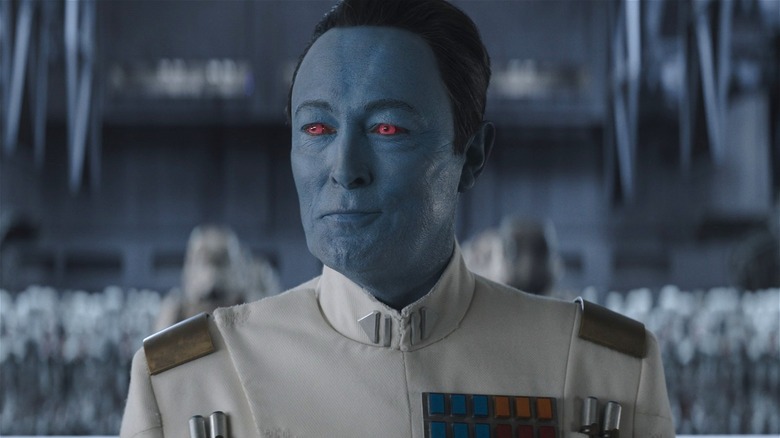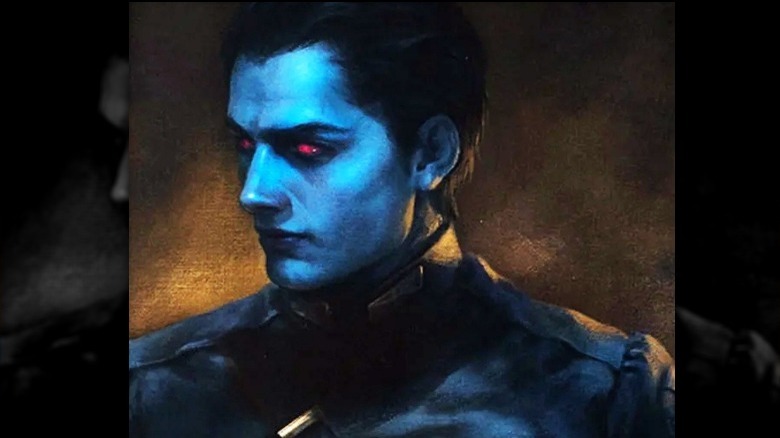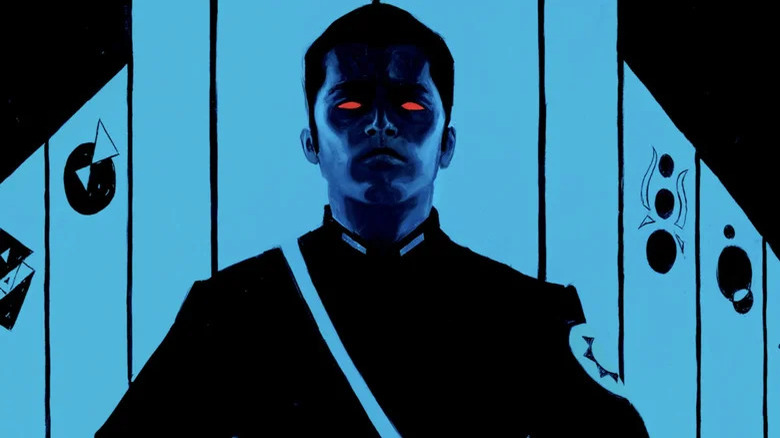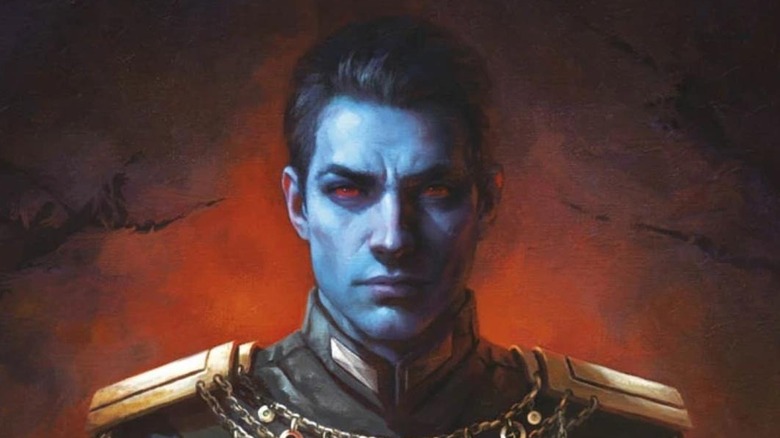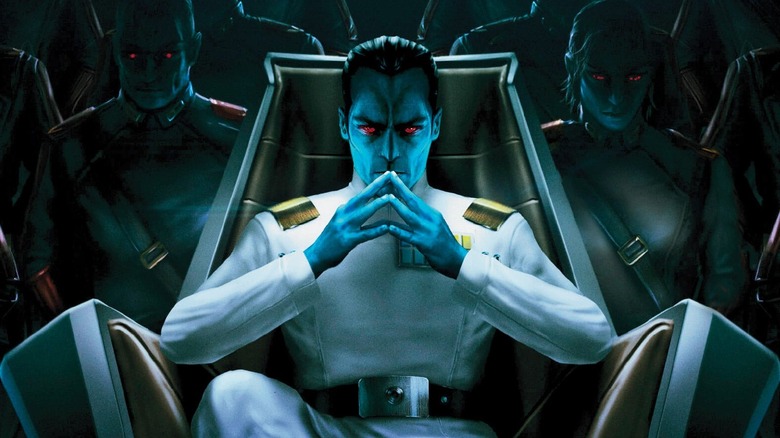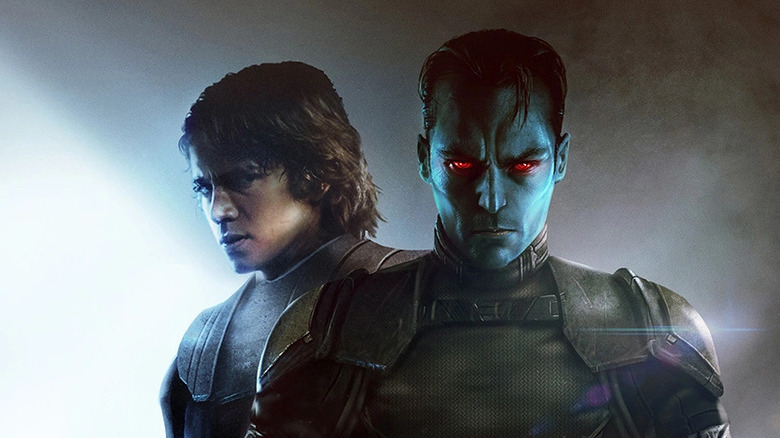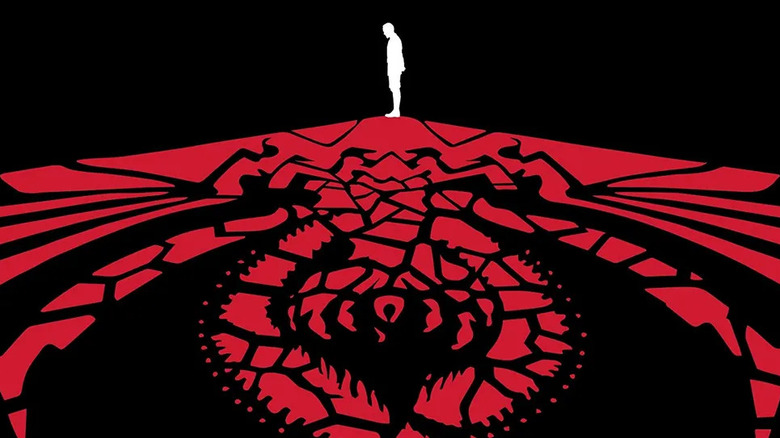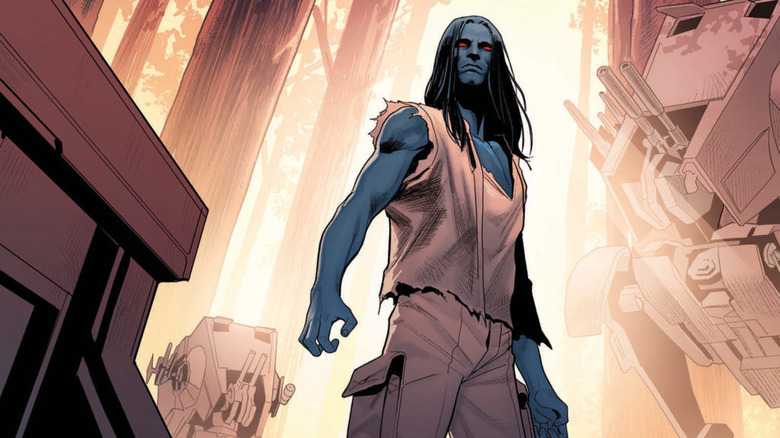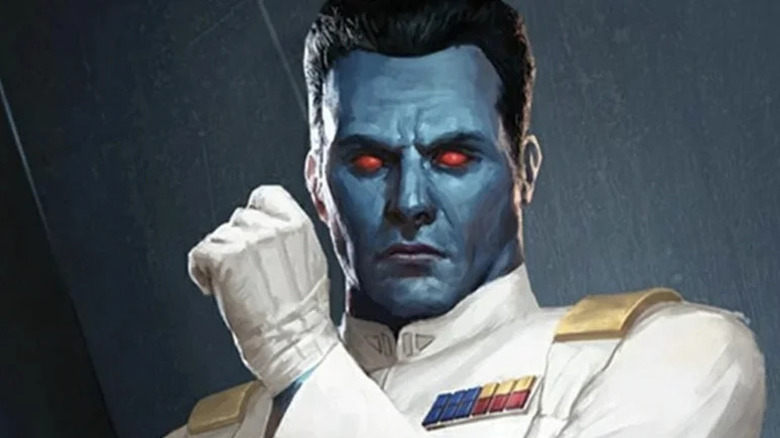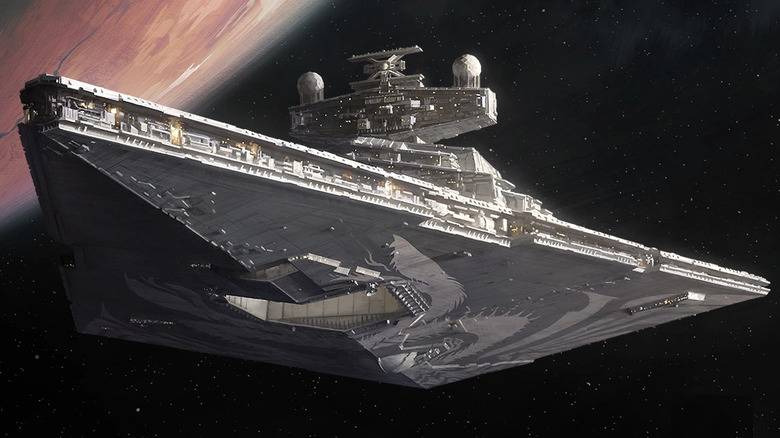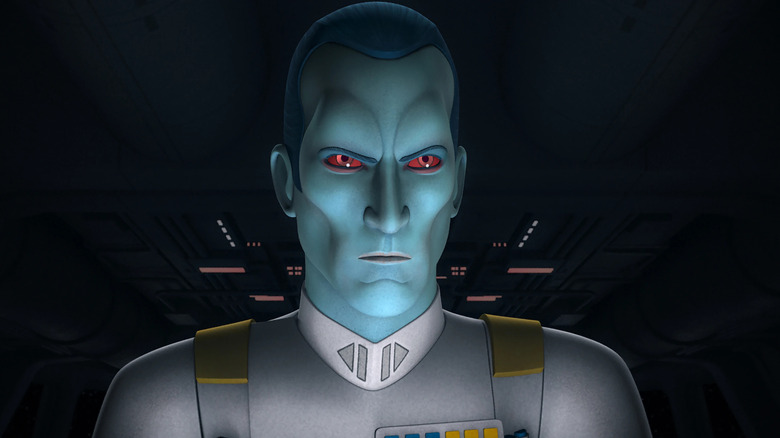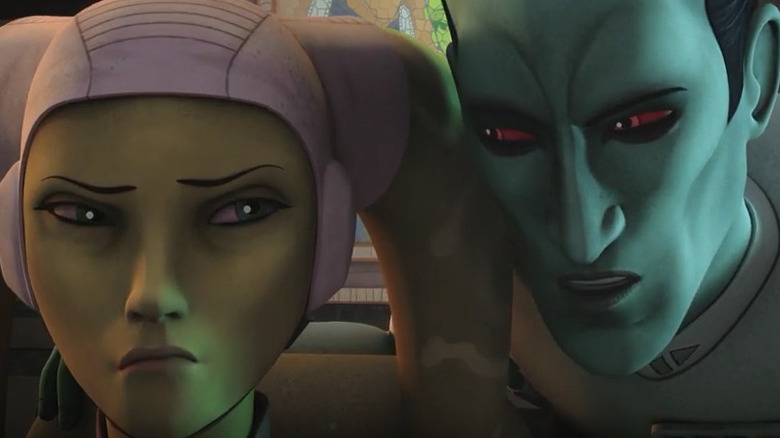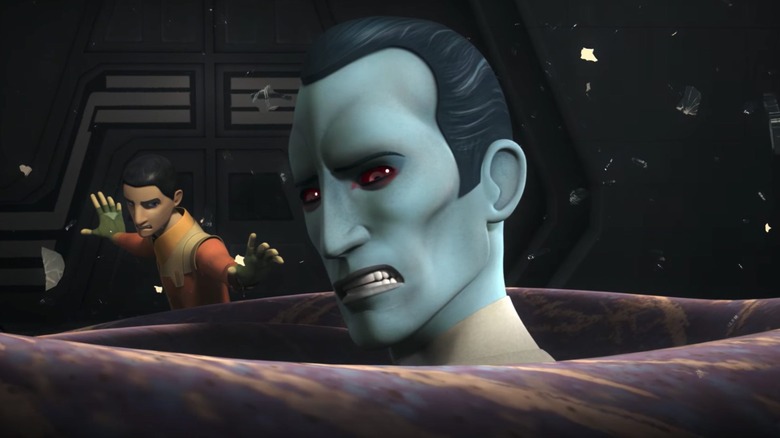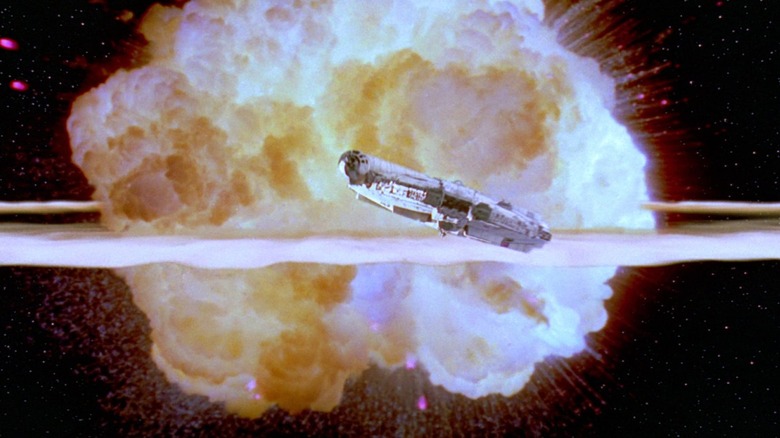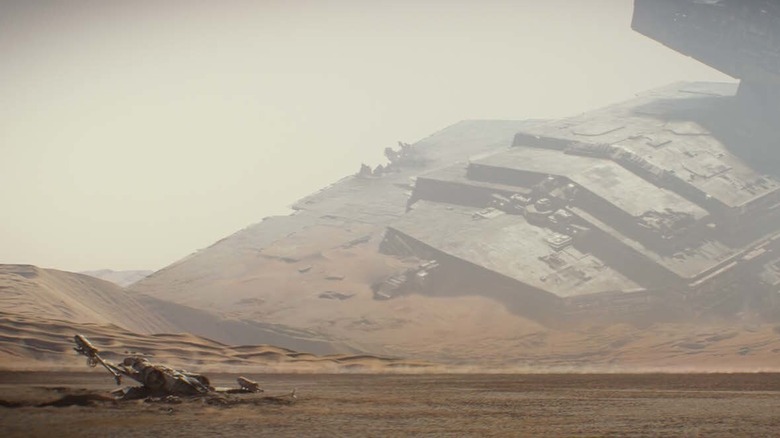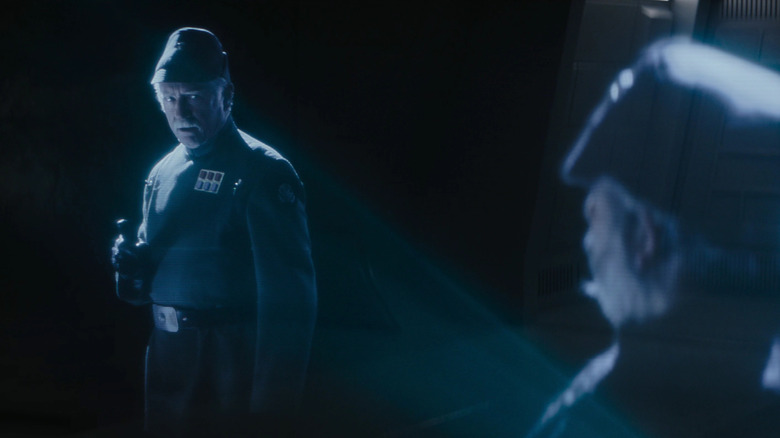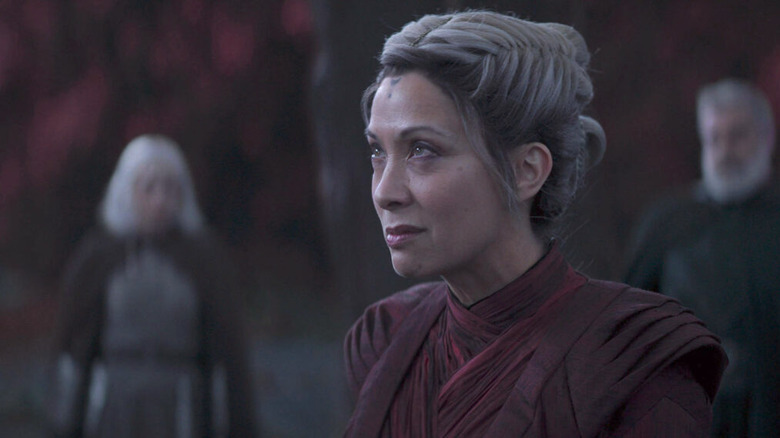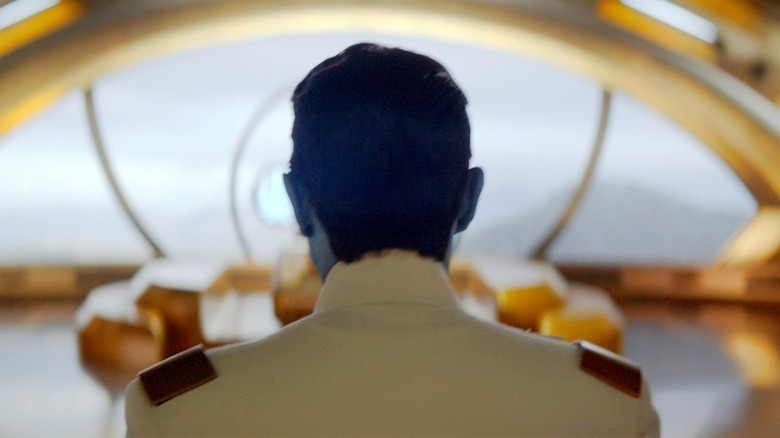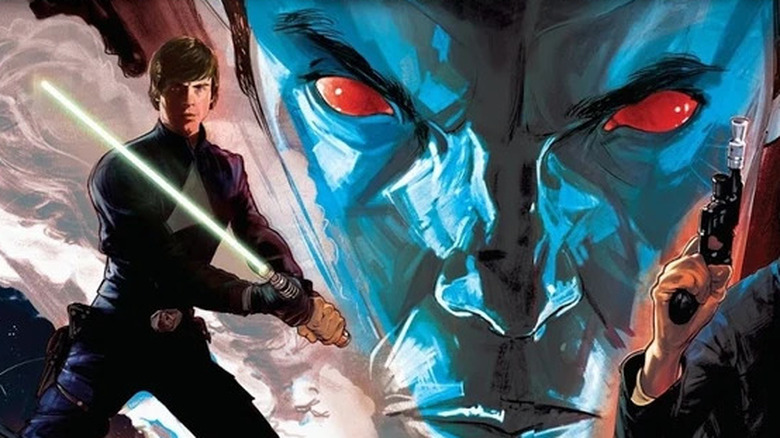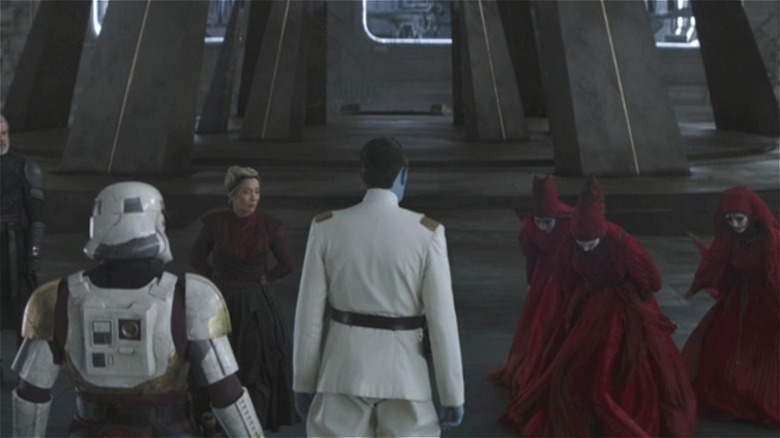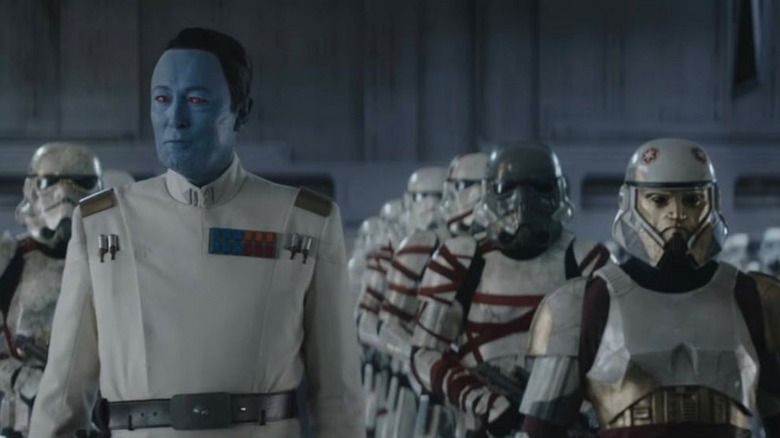The Entire Grand Admiral Thrawn Timeline Explained
He's one of the most popular and powerful characters in the 45-year history of "Star Wars." He's been immortalized as an action figure and a Funko POP. And even people who don't follow "Star Wars" have probably heard of him.
Grand Admiral Thrawn is such an impactful force within the world of "Star Wars," that the mere mention of his name can be the highlight of an episode. That's because this blue-skinned, red-eyed, sophisticated tactical mastermind changes the calculus for the Empire and the Rebels whenever he's around. He's a more nuanced and sympathetic villain than the vast majority of the galaxy's baddies, but — with the exception of Darth Vader — he's more terrifying than the rest of them, too. Never before has a "Star Wars" character been so compelling before we've had the chance to meet him in the flesh.
Fans of the franchise who consume books, comics, and the animated series have had 33 years with Thrawn already. In universe, the Grand Admiral's 70-year presence — canon and not — has directly and indirectly affected events dating back to well before the Clone Wars. Because Lars Mikkelsen has been cast to play Thrawn in "Ahsoka," we can predict that he'll continue to influence the larger "Star Wars" story beyond the present moment on the timeline. This is how Thrawn's life has intersected with the lives of other characters we know and love (or hate), and how his existence has shaped the galaxy, for better or worse.
He's born in 59 BBY
Though Thrawn was introduced in Timothy Zahn's 1991 novel, "Heir to the Empire" (which is no longer considered canon), fans learned about the origin story of the character in Zahn's 2017 canonical reboot, "Thrawn," and in the "Thrawn: Ascendency" trilogy, which was released between 2020 and 2021.
He was born Kivu'raw'nuru, the son of the lower-class Kivu family and a member of the Chiss race, on the planet Rentor around the year 59 BBY. The Chiss are biologically similar to humans except for their distinctive blue skin and red eyes which can see body temperature, mutations that developed after their part of space was all but cut off from the rest of the galaxy many thousands of years ago. Thus, the Chiss rule over a portion of the Unknown Regions, an area beyond the Outer Rim that was considered mysterious and treacherous — sometimes referred to as the Chaos — because of the highly unusual cosmic phenomena that occur there.
The Chiss navigate the Chaos with the help of temporarily Force sensitive Chiss beings — mostly girls — called sky-walkers. Kivu'raw'nuru's older sister, Kivu'rik'ardok, was one of these sky-walkers. The siblings were separated early in their childhood, which had a profound effect on Kivu'raw'nuru', or Vurawn. Chiss names are etymologically unique. The family name comes first, the first name or core name is in the middle, followed by an indicator of role or rank.
Elsewhere in the galaxy at this time, Count Dooku was promoted to Jedi Master and Qui-Gon Jinn to Jedi Knight.
He changes his name in 39 BBY
The hyper-intelligent Vurawn made a name for himself at the academy on Rentor. Though he hailed from humble beginnings, his performance attracted the attention of powerful Chiss leaders, especially Mitth'oor'akiord, or Thooraki, the head of the Mitth family. The Mitths were well-connected within the Chiss Ascendency — the non-democratic governing body made up of nine ruling families. Their hierarchies, ideologies, and political arrangements dictated the Chiss way of life. For example, the Chiss believed themselves and their culture to be superior to other species, but they strictly forbade any offensive strikes. And while they were an aristocracy, they did value ability and effort, which allowed for some class movement.
In 39 BBY, Vurawn was formally accepted into the Mitth family as a merit adoptive, which is exactly what it sounds like. The Mitths took in Vurawn as one of their own based on his potential. This involved a process known as rematching, which included a ceremony and a change of name, during which Kivu'raw'nuru became Mitth'raw'nuru, or Thrawn.
This also meant that promising student Thrawn would be expected to serve the Chiss Ascendency in a more important capacity. He was transferred from Rentor to the Taharim Academy on the planet Naporar, where cadets trained to prepare for service in the newly formed Chiss Expansionary Defense Fleet. The journey marked the first time Thrawn had ever flown in space and it would hardly be the last.
Around this time, the Trade Federation began a conflict with Kashyyyk that would last nearly 20 more years.
He graduates from Taharim Academy in 37 BBY
Thrawn continued to demonstrate his brilliance — and tendency to disregard protocol — at Taharim Academy. He was a fast learner when it came to space travel, an adept problem solver, and an intuitive strategist. His deep knowledge of and appreciation for art and culture became apparent as well, which made him even better suited to the high-ranking circles he now traveled in. But he also racked up demerits for breaking rules, like venturing into restricted zones. As he embedded himself deeper into the Chiss Aristocracy, he uncovered many secrets that had been kept from his people. Eventually, he learned that their capital, Csilla, wasn't a bustling planet of 4 billion people, but a world that was largely abandoned after climate change rendered the frozen surface uninhabitable. Thrawn also learned about the existence of an ancient super-weapon called the Starflash.
Cadet Thrawn made new friends and allies during this time. He was introduced to Mitth'ras'safis, or Thrass, a Mitth family cousin and Syndic (or Chiss politician). The two would become like brothers. Little did Thrawn and Thrass know that their relationship was being engineered by the Mitth and Stybla families for political purposes. He also befriended Senior Cadet Irizi'ar'alani, or Ziara, who came to his defense when he was accused of cheating on a test after he scored much higher than any Chiss ever had.
Thrawn graduated from Taharim Academy in 37 BBY and became a lieutenant. For comics readers, "Age of Republic — Qui-Gon Jinn" #1, in which the Jedi Knight has a crisis of faith, also takes place in 37 BBY.
Thrawn moves up and down the ranks from 37 to 19 BBY
From approximately 37 BBY to 19 BBY, Thrawn rose within the ranks of the Chiss military. However, his frequent borderline-serious infractions occasionally knocked him down a level of command or two. During these years, Thrawn cemented his reputation as a leader who would take risks — namely going on the offensive — if it might mean victory. Since preemptive strikes went against the Chiss Ascendency honor code, Thrawn's command style became a strength and a liability.
Beginning in 36 BBY, pirates began attacking the Chiss. Thrawn recognized their symbols as Lioaoin and correctly deduced that the pirates were working for the Lioaoin regime in secret. But the honor code prevented him from taking the fight to the Lioaoin unless he could prove a connection. Thrawn baited them into battle, coming dangerously close to violating Chiss military law. Thankfully, the tactic succeeded, and Thrawn was promoted two ranks, to Senior Commander. He got himself into trouble, however, defending another civilization from pirates under the guise of doing reconnaissance and providing humanitarian aid. This time, his friend Thrass had his back. Still, Thrawn was eventually demoted to Mid Commander for his aggressive interventions. But it wasn't long before he was promoted again, this time to Senior Captain, and given a new honorific suffix, making him Mitth'raw'nuruodo.
Thrawn's personal ascendancy coincided with the decline of the Galactic Republic. "Star Wars: Episode One — The Phantom Menace" and "Star Wars: Episode Two — Attack of the Clones" are set in 32 and 22 BBY respectively.
He fights alongside Anakin Skywalker in 19 BBY
For the first time in his own chronology and in canon, Thrawn comes into contact with a character from the live-action "Star Wars" universe in the 2018 book, "Thrawn: Alliances." With the Clone Wars already well underway, Padmé Amidala and her handmaiden, Duja, travel to Batuu (of Disney's Galaxy's Edge fame) to do something of great importance. When her husband, Anakin Skywalker, learns that her ship has been found vacant, he goes looking for her. Along the way, he crosses paths with Thrawn. Thrawn — always hungry to gather intel — makes a deal with the Jedi. He'll help Anakin find Padmé if Anakin will debrief him on the intricacies of the Clone Wars.
The unlikely duo is ambushed at Black Spire Outpost. Thrawn determines that Separatists are plotting to assassinate Anakin. Meanwhile, Duja is murdered when she discovers an enemy droid factory and base. Thrawn and Anakin investigate, get themselves captured, free themselves, and eventually meet up with Padmé. Thrawn even helps Padmé recover Anakin's lost lightsaber at one point. Ultimately, Thrawn and Anakin have different goals. The Chiss want to steal a deflective shield generator while the Republic wants to blow up the factory. Anakin takes things one step too far and bombs a mine, too, which Thrawn and Padmé deem a diplomatic mistake.
Having spent time with Anakin Skywalker during the Clone Wars will make it easier for Thrawn to surmise the true identity of Darth Vader down the line.
Thrawn loses a friend but gains a sigil from 19 to 18 BBY
Just as the Empire was overthrowing the Galactic Republic, Thrawn was experiencing personal gain and great personal loss. He was in command of a warship called the Springhawk, dealing with Vagaari Pirates when he lost his brother, Thrass. The Syndic, who'd joined forces with a human female pilot, sacrificed himself to save the lives aboard a Galactic Republic ship that had emerged from Lesser Space. Thrawn had achieved his part of the mission, however, apprehending a gravity well projector from the pirates.
The ruling families were glad to have the gravity well projector but much more upset about the loss of the ship and of Thrass. Thrawn was stripped of his command of the Springhawk as punishment. Within a year, he was reinstated and sent to investigate threats and protect the Dioya system. He prevailed — by disobeying orders yet again — and headed to the Rapacc system next. There, Thrawn encountered the Paccosh and their leader, Uingali. From the Paccosh, he received valuable information about the Nikardun, the Chiss' adversaries from within the Unknown Regions. And from Uligail's ring, he adopted what would become his personal sigil. The ring was engraved with a Chimaera, a multi-headed snake-like monster. The Chimaera would decorate his ship and the uniforms of his crew in the future.
Around this time, thanks to the late Thrass' data collection, Thrawn would also learn about the existence of his long-lost sister. Another character who would become vitally important to Thrawn's story was born during this year, on Empire Day no less: Ezra Bridger.
He fakes his exile in 15 BBY
Thrawn's personal philosophy may have been riskier and more aggressive than most Chiss, but on the whole, he favored spycraft over unnecessary casualties for devastation's sake. Those two facets of his personality set Thrawn up for the mission that would change the course of his life. As he was fighting the Grysks (one of the Chiss' major foes), Thrawn met some Neimoidians who had survived the Clone Wars. They proposed the Chiss fight the newly-formed Galactic Empire alongside the remnants of the Trade Federation. Sensing that Emperor Palpatine was a better ally than the Neimoidians, Thrawn hatched a plan.
In the 2018 comic "Star Wars: Thrawn" #1, the Chiss Captain arranged to have himself stripped of his title and exiled to Wild Space. His intention was to be found by Imperial forces, to gain their trust, and to infiltrate their ranks, all for his people's benefit. After a few months, in 15 BBY, Thrawn allowed himself to be captured and questioned. He was honest with Imperial Captain Park and a cadet named Vanto about the problematic preemptive strikes that led to his supposed banishment but lied about having been at his encampment for five years. He so impressed his captors, especially with his ability to speak basic, that they presented him to Emperor Palpatine as a gift. Thrawn rephrased the proposition and offered himself to the Empire as a resource knowledgeable about the Unknown Regions. Palpatine accepted and welcomed Thrawn into the Imperial Navy. Thrawn saw himself as a double agent and assumed he'd spend about a year in the Empire's service. But that's not exactly what happened.
He rises within the ranks of the Empire from 15-12 BBY
Though he was already a formidable military strategist with decades of experience under his belt, Thrawn was sent to the Royal Imperial Academy for a period of about three months. He formed an instant rapport with Emperor Palpatine, who was curious about the Unknown Regions and who shared Thrawn's appreciation for fine things. But within the Academy and within the ranks of the Empire's navy, Thrawn was not as well-liked. He even endured harassment — mostly due to bigotry toward the Chiss — but also because of his smug attitude. For the second time in his life, he graduated as a lieutenant, and cadet Vanto was assigned to be his aide. It wasn't long before Thrawn was back to his old habits, getting into scuffles with pirates, taking risks and disobeying orders (he was court-martialed for one such incident), and usually coming out on top.
In just a few short years, Thrawn was promoted from Lieutenant to Captain to First Officer to Commander, serving on the ships Blood Crow and Thunder Wasp. But, as he outshone his superiors, he created adversaries, too. To help himself politically, he made frequent visits to Coruscant where he ingratiated himself with the Empire's movers and shakers including Wullf Yularen and Arihnda Pryce.
As Thrawn was accumulating power, Darth Vader was building his fortress on Mustafar, Galen Erso was captured — and his daughter Jinn was rescued by Saw Gerrera — and Ezra Bridger's parents were killed.
He gets command of the Chimaera in about 12 BBY
Because Thrawn's story exists in so many forms, it can be tricky to pin down exactly when certain events took place if dates aren't specifically mentioned in the texts or in the series. But based on context clues, we can guess that Thrawn was given control of the Chimaera around 12 BBY. After about four years of service, Thrawn and Vanto were called back to Coruscant without explanation. For once, Thrawn was being honored instead of reprimanded or scrutinized. As it turned out, he was getting a promotion, to Commodore, and the run of a Star Destroyer. The ISD Chimaera, upon which he'd emblazoned his symbol, would become his ship from then on.
His closest associates were benefitting from his rapid ascension, too. Vanto was promoted to Lieutenant Commander, and Pryce was named the new Governor of her home planet, Lothal. After the pomp and circumstance concluded, the new Commodore Thrawn was introduced to Grand Moff Tarkin.
Commodore Thrawn and his crew aboard the Chimaera were tasked with sussing out a burgeoning Rebel insurgency. One of their leaders, who went by the code name Nightswan, had long been a thorn in Thrawn's side.
He becomes the only non-human Grand Admiral in the Imperial Navy
Thrawn's status was elevated yet again when he squelched a rebellion on Botajef and was promoted from Commodore to Admiral. He'd receive his final promotion after he finally figured out the identity of Nightswan and put a stop to another revolt ... and in true Thrawn fashion, he did it all while disrespecting his own High Command. A Rebel movement was spreading to planets like Batonn and Lothal. Thrawn was initially put in charge of crushing an insurgency on Batonn, but he turned down the job because he didn't feel there was enough intelligence to ensure victory: He was right. However, as the insurgents flew to their mobile base, Thrawn followed. There, he arranged for Vanto to be captured. As Thrawn predicted, Vanto was brought before their leader, Nevil Cygni, or Nightswan.
The Chimaera returned to Batonn and fired upon the insurgents. Cygni and Thrawn met to negotiate and realized they had much in common, including their preference to minimize loss of life in battle. Thrawn even revealed to Cygni that he was still loyal to the Chiss and not necessarily the Empire, and attempted to lure him to his personal cause. But in the end, an explosion on Batonn set off by Governor Pryce killed countless civilians, including Cygni. Though the bomb wasn't his doing, the strategy leading up to it was, and he reaped the reward. Thrawn was invited to appear before the Emperor where he was named Grand Admiral Thrawn, the only non-human to hold that position. He accepted the promotion but asked Palpatine to promise not to use the Death Star to attack his home world.
He faces off against the Rebels in 2 BBY
The Imperial Navy may have silenced the rebellion on Batonn, but Lothal still posed a problem. It's at this point on Thrawn's timeline that non-book and non-comic readers meet the Grand Admiral as he's sent to deal with the freedom fighters from "Star Wars Rebels." At the beginning of the third season, Thrawn stepped in to try and defeat the Phoenix Squadron and secure the region for the Empire.
For two seasons, he used his intellect as a strategist and his affinity for art and culture to match wits with the Rebels, and in particular, the crew of the Ghost. Thrawn connected dots, such as prison breaks and stolen ships, to put together a better picture of the insurgency he was facing. He was able to keep tabs on them thanks to Sabine Wren's graffiti, and he tricked Hera Syndulla with his knowledge of Twi'lek Kalikoris. Even when he lost — like when the Rebels bombed a Star Destroyer — he won. In that case, he got closer to uncovering their secret base.
Thrawn also identified a spy within the Empire's midst. Agent Alexandr Kallus had been turned toward the Rebel cause and had been aiding them under the codename Fulcrum. Kallus would eventually escape his grasp, but this revelation led to the discovery of the Rebel base on Atollon as well as a decisive Imperial victory there. The final showdown over Lothal resulted in the tragic death of the Jedi Kanan Jarrus, but the fallout would be much more complicated for Thrawn and Ezra Bridger.
He disappears around 1 BBY
The most recent "Star Wars" stories all revolve around one fateful decision that Ezra Bridger made in the Season 4 and series finale of "Star Wars Rebels." When Governor Pryce destroyed the fuel station that killed Kanan, she also weakened the Empire's position. With the battle at something of a stalemate and with the fate of Lothal hanging in the balance, Ezra put his plan into action. He surrendered to Thrawn, who brought him aboard the Chimaera. The Grand Admiral thought he finally had the upper hand as he lamented to Ezra that he didn't really want to lay waste to the planet. Then, one of the captains in his fleet, Pellaeon, radioed to report that Imperial ships were being destroyed and that something had materialized from hyperspace.
Ezra had commanded the crew of the Ghost to summon Purrgil, enormous space creatures that resemble a cross between a whale and a giant squid. When they arrived, he used the Force to compel them to attack the Chimaera. As one wrapped its tentacles around the Grand Admiral, he realized he'd been defeated, though he also realized whatever was about to happen to him was about to happen to Ezra too. With the ship and its inhabitants in their grasp, the Purrgil disappeared into hyperspace. Curiously, months earlier during the assault on Atollon, Thrawn had taunted an injured Bendu who foresaw his demise, describing, "many arms surrounding you in a cold embrace."
Without him, the Empire falls
After Thrawn and Ezra went missing, the Empire turned its attention away from a TIE Defender program the Grand Admiral had been spearheading on Lothal. The Emperor, Grand Moff Tarkin, and Darth Vader fully committed to the Death Star and to stamping out the Rebel Alliance, once and for all. The events of "Andor," "Rogue One: A Star Wars Story," "Star Wars: Episode IV — A New Hope," "Star Wars: Episode V — The Empire Strikes Back," and "Star Wars: Episode VI — Return of the Jedi," all take place in the next four to five years of the franchise's timeline. Cassian Andor and Jyn Erso lead a mission to steal Death Star plans, and then Jedi-in-training Luke Skywalker lands the blow that destroys the deadly space station. The Empire rebuilds, the Rebels are undeterred, and Luke helps his father to see the error of his ways. A second Death Star is destroyed and a new era with a New Republic begins.
Would it have happened differently if Thrawn hadn't been spirited away in the skies above Lothal? His reputation and track record suggest so. Had he been present during the heist on Scarif, he may have been able to prevent the domino effect that led to the Empire's collapse. Had he been in the Emperor's ear, he may have cautioned against the construction of a second Death Star, as he was always skeptical about putting the Empire's resources into one project. His disappearance also made a possible alliance with the Chiss less likely. That he's off the board during the original trilogy gives the Rebels a much better chance at success.
The Imperial Remnant retreats to the Unknown Regions in 5 ABY
Before he died, Palpatine constructed a secret observatory and computer lab on Jakku which housed his contingency plan. That plan called for Imperial forces to flee to the Unknown Regions along a path he'd charted. The Contingency became necessary when, in 5 ABY, the New Republic won a months-long battle on Jakku, after which the Empire conceded and the Galactic Civil War ended. As we see in "The Mandalorian" and "Ahsoka," many of those who'd only half-heartedly supported the Emperor changed sides once he was gone and they were given a choice. Others, still loyal to the Empire, hid in cells across the galaxy, ready to rise up when called upon. But many of the highest-ranking members, including the Hux family, went to the Unknown Regions using Palpatine's directions.
The Imperial Remnant began to rebuild there on planets like Ilum, which would be transformed into Starkiller Base nearly three decades later. Ahch-To, the planet upon which an aging Luke Skywalker would exile himself, is also located in the Unknown Regions. Much of the sequel trilogy takes place there precisely because the First Order sprung from the Imperial Remnant and gained power as it came to understand and control this once-mysterious sector of space.
Meanwhile, the New Republic began to form its government. Without a war to fight, Hera and Sabine set off for the Unknown Regions, too, to look for their friend, Ezra Bridger, who they hoped might still be alive. Elsewhere, General Leia Organa was giving birth to Ben Solo.
Captain Pellaeon's believes he'll return around 9 ABY
Thrawn's story picks back up with "The Mandalorian," which is set in approximately 9 ABY. In Season 2, Chapter 13, titled "The Jedi," Ahsoka Tano takes on Morgan Elsbeth in an effort to illicit information about her boss's whereabouts. The boss in question turns out to be none other than Grand Admiral Thrawn. Though Moff Gideon is that series' main villain, the audience starts to sense that an even bigger threat to the New Republic is looming offscreen. Confirmation comes in the form of Captain Pellaeon and the Shadow Council, who appear as holograms in Season 3, Chapter 23, "The Spies."
The Shadow Council organized after the fall of the Empire with two goals: to keep or bring the various factions loyal to the Empire together and to conceal the fact that a threat to the New Republic existed at all. Moff Gideon calls them to order to request back-up as he's about to defend his forge on Mandalore from the recently united clans. He snidely points out that Grand Admiral Thrawn is conspicuously absent from their meeting, as usual, and wonders aloud whether it's time for new leadership. Captain Pellaeon, who served under Thrawn during his time fighting Phoenix Squadron, reminds him that their plan depends upon "the secrecy of his return." This strongly implies that either Pellaeon is in contact with and taking direct orders from the Grand Admiral, or that he has reason to believe Thrawn is alive and will re-emerge to lead the fractured Empire.
Morgan Elsbeth searches for him around 10 ABY
Morgan Elsbeth and Ahsoka Tano are also holding out hope that the Chimaera and its passengers can be found. The efforts to find them serve as the main plot of the Disney+ series, "Ahsoka." We learn that Morgan was (or is) a member of the Nightsisters, an order of Force-wielding women sometimes referred to as the witches of Dathomir. When we met her in "The Mandalorian," she was the magistrate of Corvus, but she was clearly already allied with or at least inspired by Thrawn. Not only did Ahsoka believe she knew Thrawn's location, but Morgan's droids were also marked with chimaeras.
Ahsoka steals the supposed star map that leads to Thrawn and, by extension, Ezra. Morgan steals it back, and she, Baylon Skoll, and his apprentice, Shin Hati, all travel to an ancient ruin on Seatos. With the map in its proper place, Morgan believes she can hear Thrawn's call across time and space. The massive hyperspace ring she's building, the Eye of Scion, is intended to allow her to reach Peridea, an entirely separate galaxy from the one that's served as the setting of "Star Wars" thus far. The presence of Purrgill as Shin chases Ahsoka and Sabine through the space near Seatos is the strongest proof yet that there is truth to the whispered rumors of Thrawn's (and Ezra's) survival.
With her ship grounded, Ahsoka considered destroying the map to prevent the return of the presumed Heir to the Empire. A sentimental Sabine couldn't bring herself to do it, and now she, Morgan, Baylon, and Shin are en route, and Thrawn's return is imminent.
In Legends, he also reappears in 9 ABY
Thrawn's story has evolved to intersect with Anakin Skywalker, the crew of the Ghost, and the casts of "The Mandalorian" and "Ahsoka," but the character dates back to before there even was a prequel trilogy, let alone a sequel trilogy or television series. Timothy Zahn's own original trilogy of "Thrawn" novels — "Heir to the Empire," "Dark Force Rising," and "The Last Command" — tells a complete tale about how Grand Admiral Thrawn antagonized George Lucas' original trio of heroes, who appear as older versions of themselves. Interestingly, these books take place in 9 ABY as well, and, though they're not canon, they involve several recognizable characters, subplots, and themes.
Grand Admiral Thrawn and Captain Pellaeon are interested in the late Emperor's cloning operation. Han Solo and Leia Organa are married (Leia is pregnant with twins), and she's known to be Force sensitive like her brother, Luke. The Grand Admiral cooperates then clashes with a Dark Jedi named Joruus C'baoth. In some ways, their relationship mirrors the struggle for power between General Hux and Kylo Ren. The ysalamiri, or lizard-like creatures that can repel the Force, can be traced back to "Heir to the Empire" as well.
But differences abound in the "Star Wars" Expanded Universe, too. Han and Leia go on to have three children. Luke and Force-sensitive smuggler-turned-Jedi, Mara Jade, marry. They have a son and name him Ben. Most of the mayhem Thrawn causes has to do with cloaking shields. The most significant difference, however, is Thrawn's fate.
The non-canon Thrawn dies a month later
We don't know what will become of the canonical Grand Admiral Thrawn just yet. He's such an integral part of the franchise at the moment, not to mention one of the most capable villains "Star Wars" has ever had, that it seems almost certain that he'll last at least until Dave Filoni's New Republic-era movie that's said to tie together the events of the recent TV shows. It is worth mentioning he doesn't factor into the sequel trilogy, so he'll likely be taken out of the picture sometime before 34 ABY. But the Thrawn of Legends has already met his end. In "The Last Command," Grand Admiral Thrawn is betrayed and murdered by his personal bodyguard, the Noghri named Rukh — the same character who shows up during the attack on Lothal in "Star Wars Rebels."
Rukh had recently learned that the Empire wasn't helping but hurting his people. The Noghri practically worshipped Darth Vader, who promised to restore their ecosystem, which had been badly polluted during the Clone Wars, in exchange for their allegiance to the Empire. But neither the Empire nor the Imperial Remnant ever made good on that promise, which Leia revealed during the events of the "Heir to the Empire" trilogy. The Noghri blamed Thrawn and not the deceased Vader, and trusted his daughter, Leia.
While an unsuspecting Thrawn is sitting in his chair, communicating with Captain Pellaeon, Rukh stabs him in the back from behind. Grand Admiral Thrawn's last words were, "But it was so artistically done."
Thrawn is stranded on Peridea from 1 BBY to 10 ABY
The mystery surrounding Grand Admiral Thrawn and Ezra Bridger's fate is resolved in Part Six of "Ahsoka," titled "Far, Far Away." That the two characters survived their intergalactic journey was never really in doubt, at least based on casting news. The details, however, were still up in the air until the Eye of Scion transported Morgan Elsbeth, Baylon Skoll, Shin Hati, and a captive Sabine Wren to his exact location.
As the show had heavily foreshadowed, Thrawn was on Peridea and had been for more than 10 years. He still has his ship, the Chimaera, though it's worse for the wear. And he still has an army of Storm Troopers (now called Night Troopers) who are more loyal to him than ever. Fans may have noticed that without a way to replace broken parts and armor, Thrawn and his forces have taken to using a method of repair that greatly resembles the Japanese practice of Kintsugi, or the use of gold to repair while also drawing attention to the beauty in the imperfections.
In the finale, we learn that Thrawn's made judicious use of Peridea's native Nightsisters, whom he's reawakened. These Force (or Magick) wielding witches have allied themselves with the Grand Admiral. Their siren calls to Morgan Elsbeth (and possibly Captain Pellaeon) were the first step to any hope of escape. For their part, the Nightsisters get to return to their homebase in Thrawn's galaxy, Dathomir.
Thrawn returns in 10 ABY
When Ahsoka Tano manages to follow Morgan Elsbeth and company to Peridea in the mouth of a purrgil, Thrawn doesn't panic or underestimate her. Nor does he take too seriously or too lightly the threat posed by a reunited Ahsoka, Sabine, and Ezra. He sends Baylon Skoll and Shin Hati after them to no avail. Twice, he sends a limited number of fighters and troops to deal with them, but as he explains to Morgan Elsbeth and the Nightsisters, it doesn't really matter if they're killed or left behind. What the Grand Admiral has to do is keep these Jedi in various stages of training occupied long enough that they won't be able to stop their launch or board the ship.
When Ahsoka gets too close for comfort, Thrawn charges Morgan — recently gifted with the power of shadows and the Blade of Talzin — to take care of her. This sets up a rematch of the duel between Ahsoka and Morgan during which the audience first learns of Thrawn's potential survival and return. Though Ezra does manage to get on board the Chimaera (thanks to an unbelievable Force push), Sabine stays behind to fight alongside Ahsoka, who slays Morgan but fails to prevent Thrawn's departure. The last we see of him in Season 1 of "Ahsoka," he's making the hyperspace jump back to his own galaxy with cargo that sure looks like a bunch of coffins. Ezra — disguised in Night Trooper armor — rendezvous with Hera Syndulla, whose worst fear has just come true. As she'd tried to warn Mon Mothma and the New Republic, Thrawn has returned.
